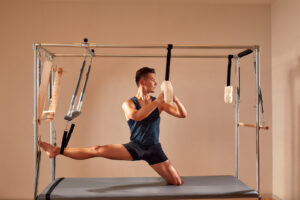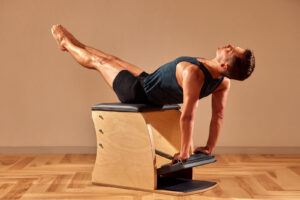If you’ve ever made a New Year’s Resolution and failed, don’t let that stop you from trying again. The most common resolutions are health or fitness-related, and there is no doubt that such lifestyle changes can be hard. However, there is one easy way to help your mind and body without spending hours slaving away in the gym or depriving yourself of the food you love.
Pilates doesn’t need to take much time, and you can go at your own comfortable pace. That’s what makes it such a great resolution, especially if your normal resolutions are usually more challenging. So, this year, here’s why you should consider Pilates as one of your lifestyle changes.

What is Pilates?
Pilates is an extremely popular form of exercise that relies on slow, controlled movements and breathing rather than intensive workouts. Primarily, people use Pilates to strengthen their core muscles, such as abdominals, hips, glutes, back and inner thighs. Unlike more stressful workouts, Pilates is all about being in control of your body. Each movement should flow smoothly into the next.
Some people confuse Pilates with yoga, but there are some key differences. Pilates is more about building functional strength, mostly in your core. Yoga is more about stretching and improving mobility. Pilates helps you achieve this too, but there is an added focus on strength. In addition, due to the slow and controlled nature of Pilates, many people find it beneficial for pain relief.
The benefits of Pilates
Pilates has grown incredibly in popularity over the last 20 years. Of course, it’s been around for a lot longer, but it is now well and truly in the mainstream fitness world. With so many people around the world doing Pilates, from professional sportspeople to the elderly, it’s clear there are some great benefits.
Improves your ability to burn fat
There is a common misconception that attending a few Pilates classes will help you shed weight. Of course, your heart rate will increase somewhat during Pilates, but it isn’t in the same league as cardio, HIIT training or even weights training when it comes to burning calories.
However, Pilates does help to strengthen muscles. When you build muscle, your basal metabolic rate also improves. This basically determines how many calories your body burns while resting. As a result, if you use Pilates to build some muscle, you’ll likely burn a few more calories over the course of a day, even if you’re not active the whole time.
Increases your flexibility
Flexibility is something that many people struggle with. In fact, many people even feel that they can’t do activities like yoga or Pilates because they’re not flexible. The truth is, you can do Pilates completely at your own pace. You’re much more aware of your body’s movements, capabilities and limitations when performing slower, controlled exercise. Therefore, you can improve flexibility no matter how tight your muscles are now.
Helps to prevent muscle strains
Many physiotherapists recommend Pilates to sportspeople, especially those who have issues with recurring muscle strains. That’s why Pilates forms a crucial part of many injury rehab programs. One of the major benefits of Pilates is that it can help you build strength and flexibility. More flexible muscles are less likely to suffer strains.
So, whether you want to just generally improve your muscle strength and flexibility, or you’re recovering from an injury and want to prevent it from recurring, Pilates is a terrific option. Naturally, it’s not the only way to prevent muscle strains, but it should certainly be considered as part of a well-rounded fitness routine.
Excellent tension release
The body’s core muscles are responsible for crucial things like posture. Poor posture can lead to serious long-term damage, but it also contributes to a build-up of tension throughout your daily life. This tension, or tightness, can often be felt in the legs, arms and shoulder, although the discomfort is usually due to weak core muscles.
In Pilates, you have a strong focus on strengthening your core. Once you’ve been doing it for a while, you should naturally start to feel less tension during and at the end of a long day. Plus, strengthening your back muscles is a great way to improve your posture and avoid long-term injuries and chronic pain.
Promotes body awareness
If you’ve ever been on a health kick before, you’ve probably submitted yourself to some pretty heavy workouts. Long cardio sessions, heavy weights training or high-intensity interval training are a few that come to mind. While these activities are also good, they do encourage you to push your body to its limits. Depending on your overall physical condition, this can be a good or bad thing.
Often, this type of heavy workout leads to overuse injuries. Pilates, on the other hand, is a low-intensity workout. Your movements need to be controlled, and this requires you to listen to your body’s signals. During Pilates, the idea isn’t to push yourself to the point of pain. But to gradually improve your strength and flexibility as your body allows.
You can do it on your own time
Finally, considering our busy lives, Pilates is a great option for an easy workout you can do at home. All you need is a mat and a Pilates program that suits you. You can find hundreds and thousands of instructional videos online, all for different capability levels. There are even online classes if you can’t get to a class in-person, or if you want to do a bit of practice before trying it out in a group.
Choose a beginner class if you’ve never done Pilates before. There are even specific Pilates classes and instructions for the elderly or those with very poor flexibility. So, if you’re worried, start there and work your way up as you improve your strength and flexibility. Even 15-30 minutes a day when it’s convenient for you will deliver results.

Looking for Pilates in your area?
MSG Physio offers guided Reformer Pilates classes. We keep our groups small, under 5 people, and classes are led by qualified physiotherapists. Whether you’re recovering from an injury or you just want to improve flexibility and core strength, contact us today to find out more.
CALL NOW TO BOOK YOUR APPOINTMENT
